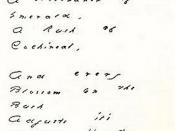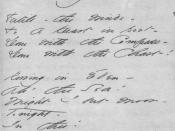Darkness is usually associated with fear or the unknown. As children, we are afraid of the unknown under our bed that darkness brings, which, in turn, makes our imaginations run wild, creating monsters, ghosts, and of course, the occasional boogeyman. Even as adults, we still have an antipathy to drive at night or go walking alone in the darkness. So it only makes sense that darkness is used in all forms of art to symbolize some kind of fear, unknown thing or place, or a mournful state. Within the world of poetry, the contrast of light and dark can be seen in hundreds of poems, including "We Grow Accustomed to the Dark" by Emily Dickinson and "Acquainted with the Night" by Robert Frost where the darkness symbolizes something much deeper than just fear.
Both poems, "We grow accustomed to the Dark" and "Acquainted with the night" use the elements of Light and Dark as symbols within the speakers' lives.
In "Acquainted with the night" the speaker talks of darkness as his past experiences, most of them not good, and perhaps the depression that accompanied them. He says, "I have walked out in the rain and back in the rain," meaning he has been through events, emotion, and sorrows through his life several times, but has managed to come through each one. He talks of how he has seen lugubrious moments when he says, "I have looked down the saddest city lane." However, he is either ashamed or just unwilling to elaborate on his experiences in the line, "I have passed by the watchman on his beat and dropped my eyes, unwilling to explain." The speaker's depression is so deep; he feels he has no hope or way of recovering. This is said in the line, "I have outwalked...



Good
great comparison. good essay
0 out of 0 people found this comment useful.